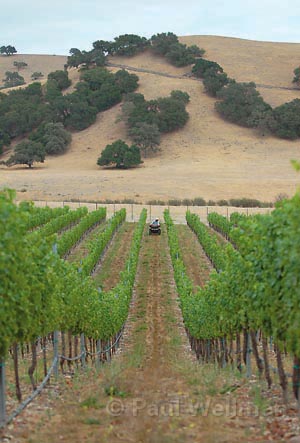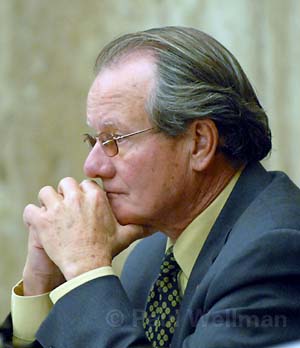Firestone Sells Family Vineyard Land
Conflict of Interest Question Over Ag Land Lingers

Brooks Firestone announced that he’s selling off his family wine company that bears his name to William Foley of for an undisclosed sum. Foley will get not just get 480 acres of Firestone land in the Santa Ynez Valley, but the Firestone name brand and the national sales organization and distribution center. The Firestone family began planting grapes in Santa Ynez back in 1972 and was among the first companies to put Santa Barbara County on the national wine map.
Firestone said Foley – who recently retired as CEO of the – will produce a first-class product. It remains unclear if the sale will remove the that prohibits Firestone, 3rd District County Supervisor, from voting on proposed policy changes governing the allowable uses for agricultural land covered by the Williamson Act. Even with the sale, Firestone still has 206 acres. With Firestone precluded from voting, the supervisors have been deadlocked two-to-two about what kind of development should be allowed. Firestone said the decision to sell had nothing to do with the conflict of interest.
Brooks Firestone announced that he’s selling off the wine company that his family spent decades building. Firestone is selling 480 acres of Santa Ynez land – 380 of which are vineyards – to Bill Foley, the retired Fidelity National Title Insurance CompanyCEO who also owns Foley Estates Vineyard, for an undisclosed sum. Along with the acreage and the physical plant, Foley is buying Firestone’s name, prestige, and national sales and distribution teams.
A third generation heir to the Firestone Tire fortune, Firestone fled Akron Ohio, where he toiled in the family business, for the bucolic bliss of the Santa Ynez Valley, where his family owned land. There, in 1972, he planted grapes for the first time. While Firestone was hardly the first vitaculturalist to see the possibilities of the Santa Ynez, he was the first to put the valley-and by extension Santa Barbara County-on the map for wine drinkers and the wine industry. Firestone hired one of the foremost oenologists of the time as a consultant to help make quality wines. He also created a sales and distribution team that was national in scope and truly “branded” the Firestone name. Firestone was also actively involved in creating a wine industry in the valley.
The first meetings of what would become the Santa Barbara County Vintners Association was held at Firestone’s. Over the years, Firestone would cede more of the day-to-day management to his son Adam, as he pursued a career in politics-first in Sacramento as an assemblymember and currently as Santa Barbara County’s 3rd District County supervisor. (Adam, meanwhile, started a very successful beer manufacturing company. That company-Firestone Walker-was not part of the sale. Today Firestone produces about 150,000 cases of wine a year. The Firestone family will keep control of three smaller wineries: Curtiss, Crossroads, and Jarhead. Of the three, Curtiss is the largest, but at 15,000 cases a year, is still tiny compared to the Firestone label.

Firestone acknowledged he felt a “little weird” about selling the winery, but said he’s confident Foley will do an excellent job. As to any lingering sentimentality, Firestone noted that he’d already sold off a portion off the family’s wine business 12 years ago-again to Foley-and before that, that he’d helped sell off the family’s tire company.
It remains unclear what if any impact the sale will have on conflict of interest findingcloud that prevents Firestone from voting on a controversial series of policy changes affecting agricultural land covered by the of Williamson Act land in Santa Barbara County. That act provides tax relief to agricultural operators who pledge to keep their land in agriculture. Many in the agricultural community agree that policy changes are necessary to keep this land both economically viable and in agriculture. But even within the agricultural and ranching communities, there’s considerable disagreement as to what those changes should be.
Some of the proposed changes have been criticized for promoting the urbanization and development. Over the past year, Firestone was accused of trying ram-rod those changes through the Board of Supervisors, a charge he vigorously denied. But before he could cast the decisive vote in favor of these proposed changes, attorneys with the Environmental Defense Center accused Firestone of having a conflict of interest. They argued his substantial land holdings could appreciate considerably in value if the policy changes were approved. At Firestone’s request, County Counsel Shane Stark investigated the matter and concluded that the conflict, in fact, existed under California law.
Since then, Firestone has recused himself, and the matter has remained bitterly deadlocked two-to-two. Firestone denied that the sale of the family winery had anything to do with these conflict charges. It’s unclear to what extent – if any – the sale will make the conflict issue go away. And even with the sale, the Firestone Family still owns 206 acres of Santa Barbara land covered by Williamson Act protections.” I was a minority shareholder in the matter before and I’m even a smaller minority shareholder now,” said Firestone. “I was told at the time, the case was a ‘wobbler,’ meaning it could go either way. Well if it was a wobbler then, it’s an even bigger one now.”
What effect the sale will have has yet to be determined. Stark has since announced his retirement, and his associate, attorney Marianne Slutsky, said she’s not sure if the conflict still exists or not. In the meantime, Firestone said – clearly in jest – that the extent to which the winery distracted him from his political obligations, the sale would make him a better supervisor. “And you know I have a long way to go,” he said.



